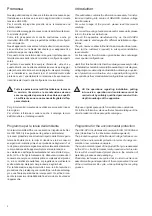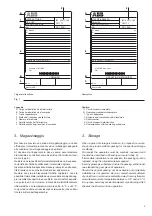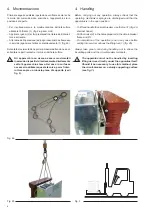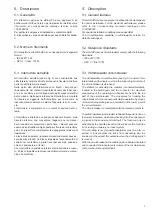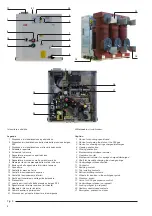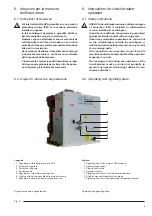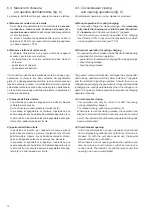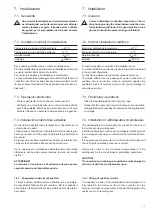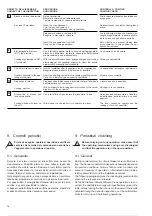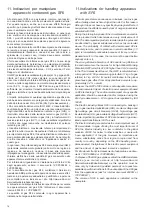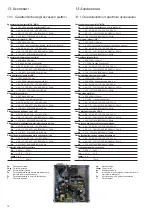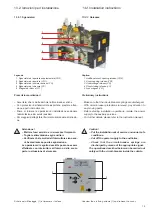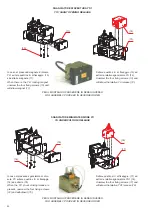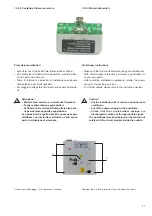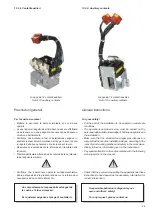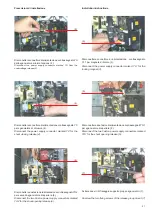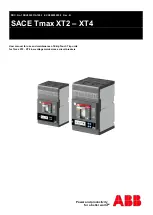
16
11. Indicazioni per manipolare
apparecchi contenenti gas SF6
Allo stato puro l’SF6 è un gas inodore, incolore, non tossico,
con una densità circa sei volte più elevata di quella dell’aria.
Per questa ragione, anche se non causa effetti fisiologici
specifici, può produrre gli effetti dovuti alla mancanza d’ossi-
geno in ambienti saturi di SF6.
Durante la fase di interruzione dell’interruttore, si genera un
arco elettrico che decompone una piccolissima quantità di
SF6. I prodotti della decomposizione rimangono all’interno
dei poli e sono assorbiti da sostanze speciali che agiscono
come setacci molecolari.
La probabilità di contatto con SF6 decomposto è estremamen-
te remota e la sua presenza in piccole quantità (1-3 ppm) è
immediatamente rilevabile a causa del suo odore acre e
sgradevole. In questo caso, il locale deve essere ventilato
prima dell’ingresso delle persone.
Il forte assorbimento infrarosso del gas SF6 e la sua lunga
durata nell’ambiente, determinano un potenziale di riscalda-
mento globale (Global Warming Potential - GWP) 22.200 volte
più elevato dell’anidride carbonica - CO2, secondo il Terzo
Rapporto di Valutazione.
Il GWP (potenziale riscaldamento globale) di 1 kg di gas SF6,
riferito ad 1 kg di CO2, viene calcolato su un periodo di 100
anni. Il suo contributo totale all’effetto globale dei gas serra,
dovuto a tutte le applicazioni, ammonta complessivamente a
circa l’0,2 %. In ogni caso, il GWP del solo gas SF6 non è
sufficiente per misurare l’impatto ambientale delle apparec-
chiature elettriche di potenza basate sulla tecnologia del gas
SF6.
L’impatto ambientale di qualsiasi applicazione specifica do-
vrebbe essere valutato e/o paragonato utilizzando il metodo
della Valutazione del Ciclo di Vita (Life Cycle Assessment) –
LCA come definito dalle norme ISO 14040. L’Industria Elettri-
ca utilizza il gas SF6 in un ciclo chiuso, per esempio all’interno
degli interruttori delle sottostazioni isolate in gas (GIS), in
interruttori di media ed alta tensione isolati in gas (GCB), in
linee ad alta tensione isolate in gas (GIL), in trasformatori di
tensione isolati in gas (GVT). In Asia, quantitativi significativi
di SF6 sono conservati anche nei trasformatori di potenza
isolati in gas (GIT).
L’Industria Elettrica è considerata l’utente più importante di
gas SF6 in tutto il mondo. Nonostante il fatto sia l’utilizzatore
più importante di gas SF6, l’Industria Elettrica contribuisce in
modo limitato all’emissione globale di gas SF6, ben al di sotto
di altre industrie o utilizzatori con “applicazioni aperte” di
questo gas.
In ogni caso, l’importanza del gas SF6 come sorgente di GWP
(potenziale riscaldamento globale) varia molto da regione a
regione e da nazione a nazione, in base alle procedure
impiegate per maneggiarlo, in base alla tenuta delle apparec-
chiature elettriche ed alla quantità di gas conservata nelle
apparecchiature elettriche di potenza.
Per informazioni riguardanti la Valutazione del Ciclo di Vita
degli apparecchi, vedere il documento 1VCP000264 o
1VCP000266).
Per lo smaltimento del gas SF6, contattare il Servizio di
Assistenza ABB perché questa operazione deve essere effet-
tuata solo da personale addestrato e qualificato. Le persone
da contattare sono indicate sul sito http://www.abb.com/
ServiceGuide/alphabetical.aspx.
A richiesta sono disponibili istruzioni specifiche per svuotare
le apparecchiature del gas SF6 (richiedere il documento
interno 650551 o 1VCP000617).
La quantità di gas SF6 contenuta in ogni apparecchio è
indicata nella targa caratteristiche.
11. Indications for handling apparatus
with SF6
SF6 in its pure state is an odourless, colourless, non-toxic gas
with a density about six times higher than air. For this reason,
although it does not have any specific physiological effects, it
can produce the effects caused by lack of oxygen in ambients
saturated with SF6.
During the interruption phase of the circuit-breaker, an electric
arc is produced which decomposes a very small amount of
SF6. The decomposition products remain inside the poles and
are absorbed by special substances which act as molecular
sieves. The probability of contact with decomposed SF6 is
extremely remote, and its presence in small quantities (1-3
ppm) is immediately noticeable because of its sour and un-
pleasant smell. In this case, the room must be aired before
anybody enters it.
The strong infrared absorption of SF6 and its long lifetime in
the environment are the reasons for its high Global Warming
Potential (GWP) which is 22 200 higher than CO2, according
to the Third Assessment Report. The GWP is calculated over
a time period of 100-years warming potential of 1 kg of a gas
referred to 1 kg of CO2. Its overall contribution to the global
greenhouse gas effect from all applications amounts to ap-
proximately 0,2 % overall.
However, the GWP of SF6 alone is not adequate to measure
the environmental impact of electric power equipment based
on SF6 technology. The environmental impact of any specific
application should be evaluated and/or compared using the
Life Cycle Assessment – LCA approach as regulated by ISO
14040.
The Electric Industry utilises SF6 in a closed cycle, banking it
e.g. in gas insulated substations (GIS), medium-voltage and
high-voltage gas circuit breakers (GCB), high-voltage gas
insulated lines (GIL), gas insulated voltage transformers (GVT).
In Asia, significant quantities of SF6 are banked in gas insu-
lated power transformers (GIT) as well.
The Electric Industry is reported as the most important user of
SF6, worldwide. In spite of being the most important user of
SF6, the Electric Industry is a low contributor to the global
emission of SF6, far below to other industries or users with
“open application” of the gas. However, its importance as
source substantially varies from region to region and from
country to country, depending on the SF6 handling proce-
dures adopted, the tightness of the electric power equipment
and the amount of gas banked in electric equipment.
For info about Life Cycle Assessment of apparatus, see docu-
ment 1VCP 000264 or 1VCP000266).
To dispose of the SF6 gas, please contact the ABB Assistance
Service (see contact persons at http://www.abb.com/
ServiceGuide/alphabetical.aspx) as this operation must be
done only by trained and qualified personal; on request are
available specific instructions for the evacuation of the SF6 gas
from the apparatuses (ask for internal document 650551 or
1VCP000617).
The volume of SF6 in each apparatus is indicated on the
nameplate.

